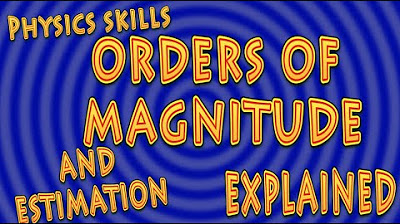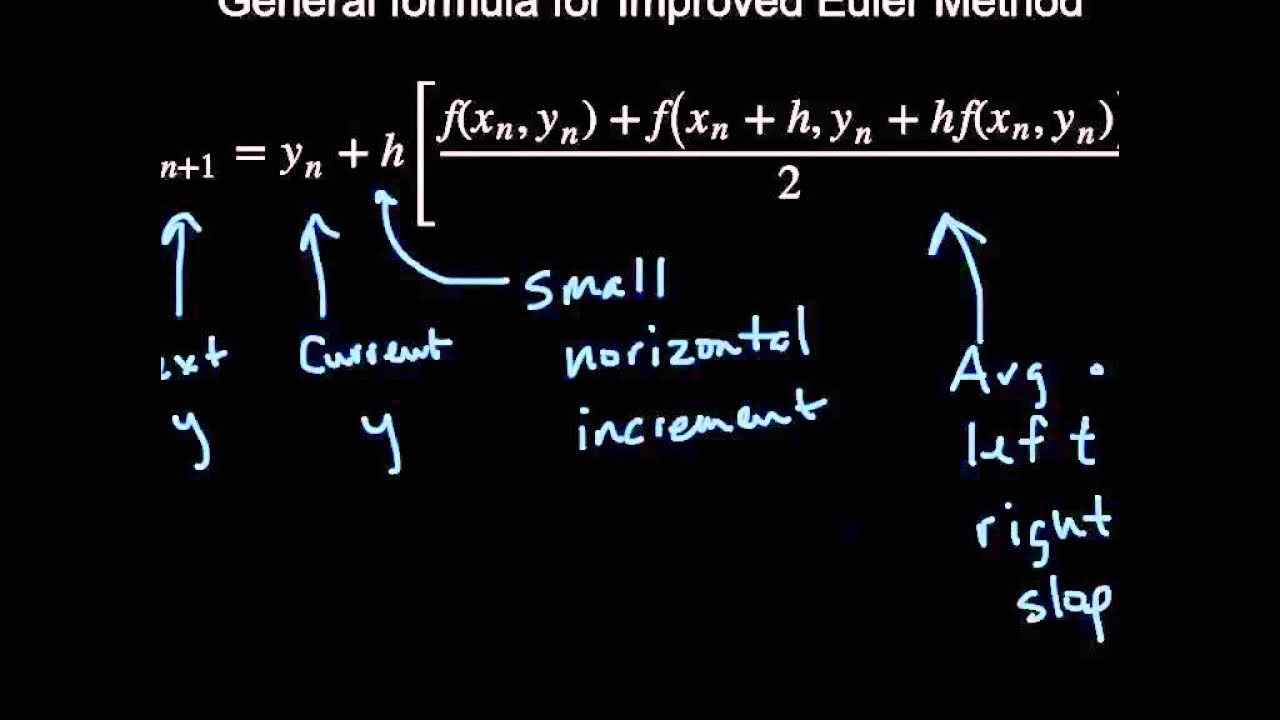UP1 (1B) Order of magnitude estimations
TLDRIn this transcript, Dr. Vive delves into the concept of order of magnitude estimates, a method for approximating values in powers of ten. He emphasizes the importance of being bold and making quick, yet informed, decisions when estimating. Using the IEEE convention, Dr. Vive illustrates the process with two examples: estimating the number of hydrogen atoms in an apple and the total number of atoms in the universe. He also applies the 'Goldilocks method' to find the ideal size of an apple and to estimate the daily amount of gasoline pumped in Rochester. The transcript highlights the power of estimations in providing quick insights that are likely to be close to those of more complex calculations.
Takeaways
- 🔢 Order of magnitude estimates are used to find approximate values in powers of 10, focusing on the exponent (m) rather than the coefficient.
- 📈 The IEEE convention simplifies numbers less than 5 to 10^0 and rounds numbers 5 or greater as an additional power of 10.
- ⚖️ When a number is exactly 5, a judgment call is made based on the importance of precision in the calculation.
- 📚 Rules of exponents are crucial for estimation, including multiplication (a+b), division (a-b), and power (a^b) of powers of 10.
- 🦁 The Goldilocks method helps find the 'just right' estimate by comparing different powers of 10 to the actual size or quantity in question.
- 🍎 To estimate the size of an apple, consider it's diameter in centimeters and use the Goldilocks principle to land on 10 cm as the average size.
- 🧠 Estimating the number of hydrogen atoms in an apple involves dividing the volume of the apple by the volume of a hydrogen atom, assuming both are spherical.
- 🌌 Estimating the number of atoms in the universe involves calculating the number of hydrogen atoms in the sun and then scaling up to all the stars in the galaxy and the universe.
- ☀️ The sun's mass is predominantly hydrogen, and its mass compared to that of a hydrogen atom gives an estimate of the total number of hydrogen atoms in the sun.
- 🚗 For estimating the total gallons of gas pumped in Rochester daily, consider the population, number of cars, frequency of filling up, and the average gallons per fill-up.
- 🌟 Each galaxy has about 10^11 stars, and with a trillion galaxies, you can estimate the total number of stars and, by extension, the number of atoms.
- 📊 Estimations are valuable as they provide a ballpark figure that is likely to be close to what others might calculate, even if not exact.
Q & A
What is the concept of order of magnitude estimates?
-Order of magnitude estimates is a method to find approximate values of something in powers of 10, often represented as a number times 10 to the power of an exponent (m). The focus is on determining the exponent 'm', rather than the coefficient.
What is the IEEE convention for handling numbers in order of magnitude estimates?
-The IEEE convention states that if the number is less than 5, it is considered as 10 to the power 0, and if it is greater than or equal to 5, it can be considered as an additional power of 10. If the number is exactly 5, a judgment call is made based on the importance of the calculation.
What are the basic rules of exponents that Dr. Vive mentioned?
-The basic rules of exponents are: 1) 10^a * 10^b = 10^(a+b), 2) 10^a / 10^b = 10^(a-b), and 3) (10^a)^b = 10^(a*b). These rules help in simplifying and combining powers of 10 in estimations.
What is the Goldilocks method and how is it used in estimation?
-The Goldilocks method is a way of finding an 'ideal' size or value by considering the extremes and then selecting a middle value that seems 'just right'. It is used in estimation to quickly find a reasonable estimate by eliminating values that are too small or too large.
How did Dr. Vive estimate the size of an apple in powers of ten?
-Dr. Vive estimated the size of an apple by comparing it to known sizes in powers of ten. He ruled out 10^0 centimeters (too small) and 10^2 centimeters (too large), and concluded that 10^1 centimeters is the Goldilocks estimate for the size of an apple.
What is the estimated number of hydrogen atoms in an apple?
-Dr. Vive estimated the number of hydrogen atoms in an apple to be about 10^27, based on the assumption that an apple has about a thousand moles of material and that each 'apple atom' consists of about 10 hydrogen atoms.
How did Dr. Vive estimate the number of atoms in the universe?
-Dr. Vive estimated the number of atoms in the universe by first calculating the number of hydrogen atoms in the sun, then multiplying that by the number of stars in a galaxy, and finally by the number of galaxies. He used the Goldilocks principle and IEEE convention to make bold, yet reasonable, assumptions.
What is Avogadro's number and how does it relate to the estimate of atoms in an apple?
-Avogadro's number is approximately 6 x 10^23, which represents the number of particles in one mole of a substance. Dr. Vive's estimate of 10^27 atoms in an apple is roughly a thousand moles, which is a large number but comparable to Avogadro's number.
What is the significance of estimation in scientific calculations?
-Estimation is significant in scientific calculations as it allows for quick approximations that can be used to understand the scale and magnitude of phenomena without needing precise measurements. It also provides a basis for more refined calculations if needed.
How did Dr. Vive estimate the total gallons of gas pumped in Rochester daily?
-Dr. Vive estimated the total gallons of gas pumped in Rochester daily by considering the population, the number of cars per person, the frequency of filling up gas, and the average gallons filled per car. He used the Goldilocks principle to find reasonable estimates for each factor.
What is the importance of being bold in estimations?
-Being bold in estimations is important because it allows for quick and efficient approximations without getting bogged down in precise details. It also encourages the use of order of magnitude thinking, which can lead to a better understanding of the scale of the problem at hand.
How can the IEEE convention simplify the process of estimation?
-The IEEE convention simplifies the process of estimation by allowing for the rounding of numbers to the nearest power of 10, which makes calculations more manageable and the results easier to communicate. It also provides a standardized approach to handling numbers in scientific and engineering estimates.
Outlines
🔢 Understanding Order of Magnitude Estimates
Dr. Vive introduces the concept of order of magnitude estimates, which is about finding approximate values in powers of 10. He emphasizes that the focus is on determining the exponent 'm', not the coefficient. Using the IEEE convention, numbers less than 5 are considered as 10^0, and those greater than or equal to 5 are an additional power of 10. The Goldilocks method is mentioned for estimation, which involves finding the 'just right' size or value. An example is given to estimate the size of an apple, concluding that it is about 10 centimeters in diameter, which is 10^1 centimeters. The principle is applied to estimate the number of hydrogen atoms in an apple, assuming the apple is made up of hydrogen atoms, and using the size of a hydrogen atom as a basis for calculation.
🌌 Estimating Atoms in an Apple and the Universe
The video continues with an estimation of the number of hydrogen atoms in an apple, using its approximate diameter and the size of a hydrogen atom. The volume of the apple is assumed to be spherical, and the same for the hydrogen atom, leading to a calculation based on the cube of their diameters. The number of atoms is then estimated to be around 10^27, which is close to Avogadro's number, suggesting the apple contains about a thousand moles of material. The method is then used to estimate the number of atoms in the universe, considering the mass of the sun, which is predominantly hydrogen, and scaling up to the number of stars in the Milky Way and the number of galaxies in the universe. The final estimate for宇宙 (the universe) is 10^80 atoms, demonstrating the power of estimation with bold assumptions.
🚗 Estimating Gas Consumption in Rochester
The third paragraph demonstrates the estimation process with a practical, local example: the total gallons of gas pumped in Rochester daily. Using the Goldilocks principle, Dr. Vive estimates the population of Rochester to be around 10^6, the number of cars to 10^5, and the frequency of gas filling to every 10 days with an average of 10 gallons per fill-up. This leads to an estimation of 10^5 gallons of gas used per day in Rochester. The importance of bold assumptions in estimation is highlighted, noting that while different people might come up with slightly different numbers, the orders of magnitude are likely to be similar.
Mindmap
Keywords
💡Order of Magnitude Estimates
💡IEEE Convention
💡Goldilocks Method
💡Exponent Rules
💡Hydrogen Atom
💡Volume Estimation
💡Avogadro's Number
💡Cosmic Nature
💡Spherical Assumption
💡Estimation Courage
💡Daily Gas Consumption
Highlights
Order of magnitude estimates involve finding approximate values in powers of 10
IEEE convention is used to determine the exponent m in a number less than or greater than 5
Estimation requires rules of exponents such as a*b = a^(b) and a/b = a^(b-1)
The Goldilocks method is used to find the ideal size of an object, like the diameter of an apple
An apple is estimated to be 10^1 cm in diameter based on the Goldilocks principle
The number of atoms in an apple is estimated to be around 10^27 using volume ratios
Avogadro's number is 6*10^23, so an apple contains about a thousand moles of material
Estimation allows you to quickly calculate the number of atoms in the universe as 10^80
The mass of the sun is 2*10^30 kg, with hydrogen atoms making up most of it
The Milky Way galaxy has about 10^11 stars, with a trillion galaxies in the universe
Estimation is a powerful tool for quickly approximating large quantities like the number of stars or atoms
Being bold and making educated guesses is key to successful estimation
Estimation can be applied to practical problems like calculating the total gallons of gas pumped in a city daily
Using the Goldilocks principle, the number of cars and frequency of gas fills can be estimated to find total gas usage
Estimation provides a close approximation to the true value, with differences likely to be small
Encourages readers to practice estimation themselves by taking on challenging problems
Estimation is a valuable skill for physicists and can be applied to a wide range of problems
Transcripts
5.0 / 5 (0 votes)
Thanks for rating:





